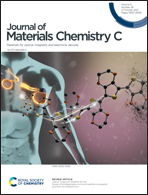Insights into molecular packing effects on the emission properties of fluorenone-based molecules in the aggregate state†
Abstract
Aggregation-induced emission (AIE) has attracted great attention during the past two decades, and preventing strong π–π interactions in the aggregate state has been widely accepted as a strategy that brings an AIE effect. However, the relationship among the molecular structure, molecular packing, and emission properties of AIE-active molecules remains unclear. Herein, we have systematically investigated the emission properties of four fluorenone derivatives and have found that changing the substituents and substitution positions results in significantly different emission characteristics. 27-DPA exhibits a nearly quenched emission in both the solution and the aggregated states, while its regioisomer, 36-DPA, is a typical AIE molecule. In addition, two-color polymorph-dependent emission can be found for 36-TPA. X-ray single-crystal analysis was then conducted to understand these distinct emission properties. Our results emphasize the importance of molecular packing modes on the AIE effect, in particular for molecules containing molecular rotors, and further show that the formation of a three-dimensional molecular packing network is an effective way to suppress molecular motions to achieve AIE properties.

- This article is part of the themed collection: Journal of Materials Chemistry C HOT Papers


 Please wait while we load your content...
Please wait while we load your content...